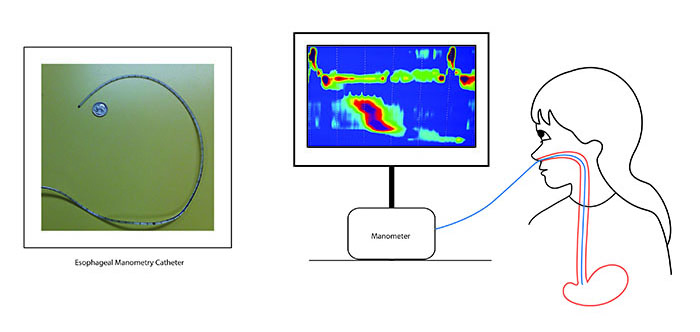Home → Manometry & 24 Hours PH Study

An esophageal motility study (EMS) or esophageal manometry is a test to assess motor function of the upper esophageal sphincter (UES), esophageal body and lower esophageal sphincter (LES).
An EMS is typically done to evaluate suspected disorders of motility or peristalsis of the esophagus. These include achalasia, diffuse esophageal spasm, nutcracker esophagus and hypertensive lower esophageal sphincter. These disorders typically present with dysphagia, or difficulty swallowing, usually to both solids and liquids even initially. Other patients with spasm disorders may have the test done to diagnose chest pain thought not to be of cardiac cause.
The test is not useful for anatomical disorders of the esophagus (that is, disorders that distort the anatomy of the esophagus), such as peptic strictures and esophageal cancer.
A technician places a catheter into the nose and then guides it into the stomach. Once placed in the stomach lining, the catheter is slowly withdrawn, allowing it to detect pressure changes and to record information for later review. The patient will be asked at times to take a deep breath or to take some swallows of water. The degree of discomfort varies among patients. Patients are not sedated because sedatives would alter the functioning of the esophageal muscles. Overall the procedure takes about 45 minutes. After the procedure is complete, patients can usually resume their normal daily activities.
Esophageal pH monitoring is a test that measures how often stomach acid enters the tube that leads from the mouth to the stomach (called the esophagus). The test also measures how long the acid stays there.
A thin tube is passed through your nose or mouth to your stomach. The tube is then pulled back into your esophagus. A monitor attached to the tube measures the acid level in your esophagus.
You will wear the monitor on a strap and record your symptoms and activity over the next 24 hours in a diary. You will return to the hospital the next day and the tube will be removed. The information from the monitor will be compared with your diary notes.
Infants and children may need to stay in the hospital for the esophageal pH monitoring.
This test can also be done during upper GI endoscopy by clipping a pH monitor to the lining of the esophagus.
Your health care provider will ask you to not eat or drink after midnight before the test. You should also avoid smoking.
Some medicines may change the test results. Your provider may ask you to not take these for between 24 hours and 2 weeks (or more) before the test. You also may be told to avoid alcohol. Medicines that you may need to stop include:
Adrenergic blockers
Antacids
Anticholinergics
Cholinergics
Corticosteroids
H2 blockers
Proton pump inhibitors
DO NOT stop taking any medicine unless told to do so by your provider.
You briefly feel like gagging as the tube is passed through your throat.
Why the Test is Performed?
Esophageal pH monitoring is used to check how much stomach acid is entering the esophagus. It also checks how well the acid is cleared downward into the stomach. It is a test for gastroesophageal reflux disease (GERD).
In infants, this test is also used to check for GERD and other problems related to excessive crying.
Normal Results
Normal value ranges may vary depending on the lab doing the test. Talk to your provider about the meaning of your specific test results.
Increased acid in the esophagus may be related to:
arrett esophagus
Difficulty swallowing (dysphagia)
Esophageal scarring
Gastroesophageal reflux disease (GERD)
Heartburn
Reflux esophagitis
You may need to have the following tests if your provider suspects esophagitis:
Barium swallow
Esophagogastroduodenoscopy (also called upper GI endoscopy)
Rarely, the following may occur: Arrhythmias during insertion of the tube Breathing in of vomit if the catheter causes vomiting